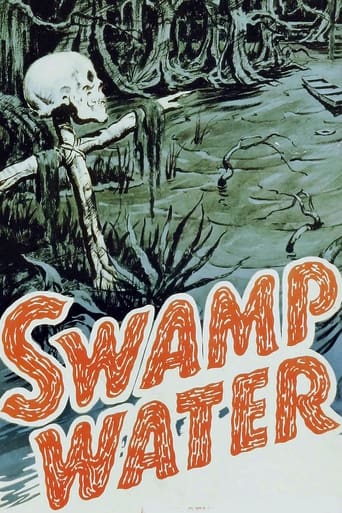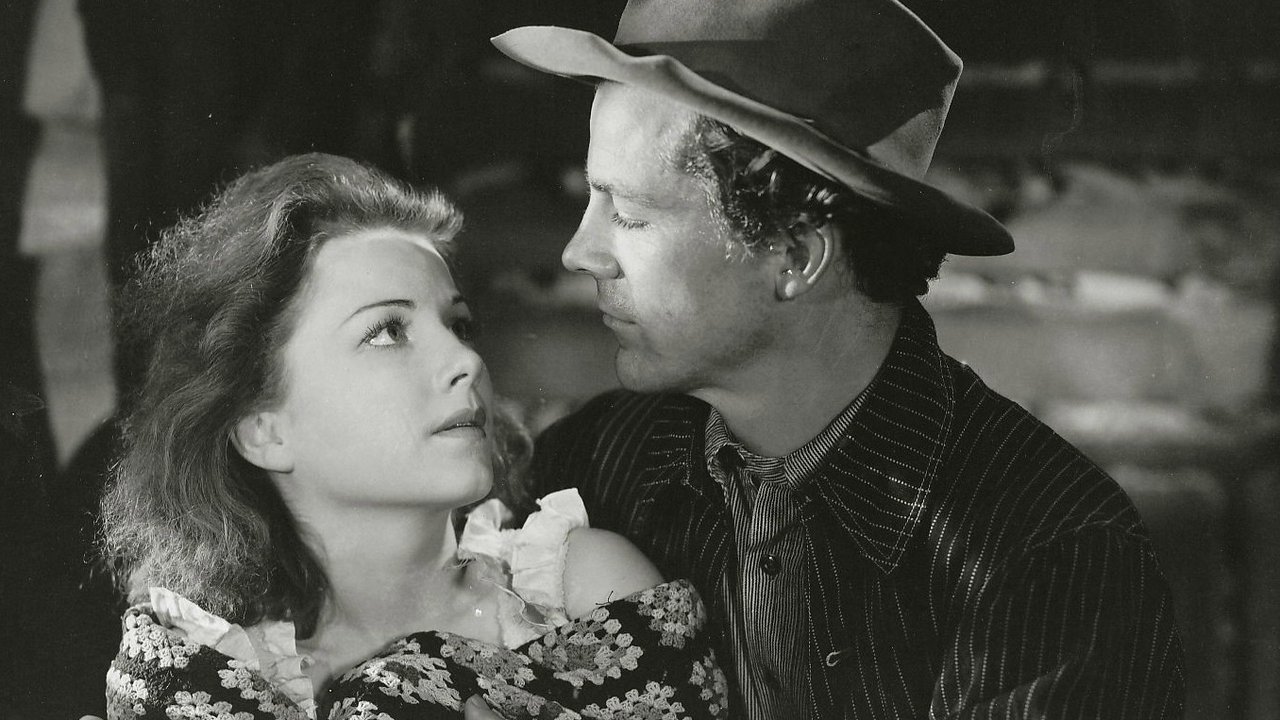bkoganbing
Jean Renoir the director of La Bete Humaine and Grand Illusion arrived at our shores in 1941 looking for employment in his field. I don't think anything in his life ever prepared him for doing a story such as Swamp Water with characters as American as you can get. In fact watching Swamp Water I would swear it was something directed by John Ford. Renoir probably got a few pointers from him by studying Ford's work or even in conversation.These rustic folks from the Okefenokee Swamp could have come out of work like Tobacco Road or The Grapes Of Wrath. Renoir certainly had an eye for scenery and an ear for speech idiom like he'd been born here. He also assembled a group of players who were perfectly cast by 20th Century Fox. Several of them in fact were veteran members of the John Ford Stock company.Young Dana Andrews son of Walter Huston and stepson of Mary Howard defies his father to go looking for his prized hound dog in the swamp and comes across the notorious Walter Brennan who was convicted of murder but escaped and has been living in the Okefenokee for several years. It's not easy but the two of them bond and become trapping partners. Of course Brennan can't come out of the swamp lest he face the hangman.Andrews also finds out that Anne Baxter is Brennan's daughter living under an assumed name. She becomes a problem because Andrews is keeping company with the flirtatious Virginia Gilmore, a swamp vixen if there ever was one. We also learn the truth about the murder Brennan is accused of.Renoir did some actual shooting in the Okefenokee and 20th Century Fox did a fine job in blending it with studio footage. The ensemble cast is first rate, but the one who stands out for me is Virginia Gilmore. Her character is definitely one that you would find more in French cinema. I guess Renoir had to bring something from France for his American masterpiece.And it is a masterpiece. And you'll swear it's a John Ford film.
LobotomousMonk
An ironic theme runs through this first American Renoir film - Fear Nature! Obviously, Zanuck and 20thC. Fox could have cared less about what Renoir had developed in his oeuvre up to that point. What mattered to them was that he had a reputation. Of course, in effect Zanuck could have found out Wayne Gretzky was a great athlete and so handed him a baseball bat requesting grand slam homeruns. Despite the troubles with the ignorant Hollywood producers, Renoir managed to direct a film and tell a story that is endearing and enduring. He also purveyed as much of his stylistic grace as was possible under the conditions (but it wasn't much). Great depth of field is utilized but conformed to a Hollywood brand of specularity - the gaze of the Other! Overall, Renoir has his hands tied as shot-reverse-shot systems, one-shot closeups, plan americain shot scales and decoupage classique continuity dominate. Even rear projection is used for the sky! When the camera isn't sneaking through the swamp representing the gaze of the other, the story is allowed to be told fluidly. Brutality versus chastity, God versus nature, redemption versus utilitarianism all have something strongly connected to Renoir's oeuvre. Brutality/Chastity in Swamp Water plays out at the bar and in Renoir's silent films like La Fille. God/Nature is continuously at play with Renoir especially in his inclusion of tropes like the river and the Pan character while in Swamp Water prayer can miraculously heal snake bites. Redemption/Utilitarianism was at the center of La Chienne, M. Lange, Bas Fonds and Marseillaise while in Swamp Water it is appropriated for familial relationships where one father uses his reputation to protect his kin and another father must redeem his reputation to do the same. Are these big ideas and themes dumbed-down then in Swamp Water? I believe that they are at the service of an audience that promotes film as escapist first and foremost. Therefore, the themes are played out with depth, but require some bushwhacking and personal exploration to access those deeper meanings. This film gets a lift from great acting (thank Renoir for that). Polyvocal systems from films like Illusion are replaced in Swamp by polytonal systems of Ben who speaks one way with the tom-girl (big papa), another with the blondie (suave romantic) and another with his father (whipping boy). This polytonal form contributes to added psychological identification. The rear projection was surely enjoyed by Zanuck while he was making love to his blow-up doll and munching on a Big Mac. The ascetic based answers provided for issues of freedom and justice are quaint for a contemporary viewer. Another inversion from Renoir's French work to Swamp Water is in its politics of justice where crime of necessity (M. Lange) is domesticated into crimes of opportunity while the revolutionary spirit of agitation disrupting order is status quoed into agitation ordering disruption. It might seem that this film is common, corny or campy... but Swamp Water somehow makes it out alive (like its characters from the swamps). For a North American viewer, the direction of Renoir leads to a fluid and clear telling of a story that has inherent appeal from the New World value system and is perhaps relayed better through the Frenchman than through a Hollywood director.
writers_reign
At the time this was shot there was a distinct lack of sound technique and for a while it's disconcerting to hear Dana Andrews and Walter Brennan talking in the heart of a swamp in the the clear 'clean' tones that all but scream 'Post-sync'. Renoir was given a mish mosh of a cast for his US debut, Walter Brennan, Eugene Palette, Dana Andrews, Ann Baxter, Ward Bond, Russell Simpson, John Carradine, not the kind of mix that works particularly well. Andrews sticks out like a sore thumb - he's a fine actor but he has 'urban' written all over him whereas most of the others can pass for rural. The plot is our old friend the innocent man framed for a murder he didn't commit just transplanted from the big city to the big - seven hundred miles - swamp. Interesting curio with Andrews rehearsing for the Ox-Bow Incident.
dougdoepke
Backwoods trapper protects fugitive at same time he courts fugitive's daughter and feuds with his stepfather, while authorities close in.Considering the talent involved (director Renoir, screenwriter Nichols), the movie's a disappointment. I know this is a minority opinion; however, in my view, the movie's pulled down by two factors—excessive theatricality (mainly Andrews & Gilmore) and phony rustic dialog. Hollywood was always at its dialog riskiest when putting words in the mouth of either the noble primitive or the backwoods illiterate. Here, it's the latter and I defer to reviewer Terrell 4 who cites good examples. The trouble is these two negative factors opened a distance between me and the screen, such that I couldn't suspend my disbelief. It was always a movie I was watching, not participating in.That's not to say there aren't positive features. Walter Brennan appears a natural for his role and again shows why he was one of Hollywood's finest, most versatile actors. (Leonard Maltin who thinks Brennan miscast must be holding a grudge.) And I like Mary Howard as Hannah. She projects a quiet dignity and kindness just right for the role. Also, the location shots of the Okefenokee lend an authentic air. But, I would suggest to folks who like this film that they catch up with Frank Borzage's 1948 film Moonrise. The theme of outcasts among a backwoods swamp is quite similar to here, but the poetical treatment is, I believe, consistently superior.In passing—Renoir's 1945 film The Southerner may have been inspired by the defects he couldn't undo in this film (Swamp Water was assigned him, he didn't choose it). The 1945 movie is also about the rural South, but much less artificial, without either the theatrical acting or the corn-pone dialog. Certainly, it's much closer to his usual style, and more of what would be expected of a world-class moviemaker.


 AD
AD


